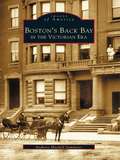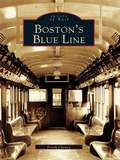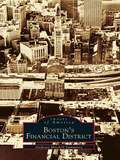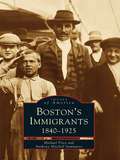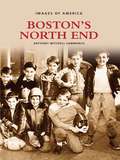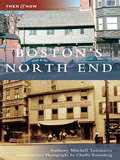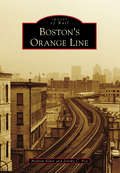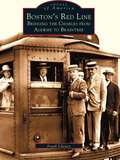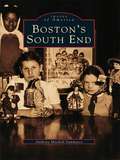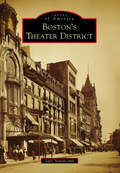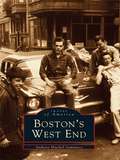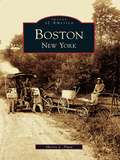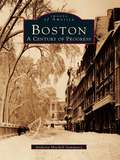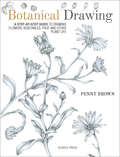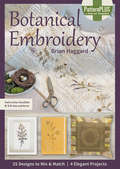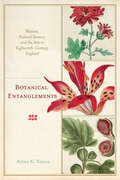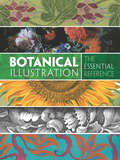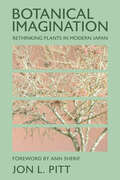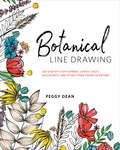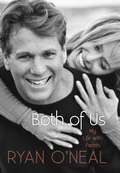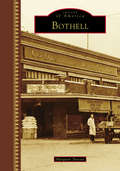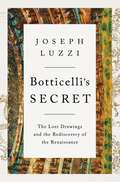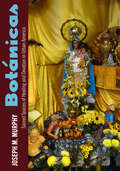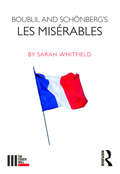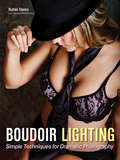- Table View
- List View
Boston's Back Bay in the Victorian Era
by Anthony Mitchell SammarcoThe Back Bay was one of Boston's premier residential neighborhoods between 1837 and 1901. From its quagmire beginnings and with the creation of the Boston Public Garden in the 1830s, the Back Bay was envisioned as an urbane and sophisticated streetscape of stone and brick row houses. The major center of the neighborhood became Art Square, now known as Copley Square, which was surrounded by Trinity Church, New Old South Church, Second Church of Boston, the Boston Public Library, and S.S. Pierce and Company. With images of swan boats and architectural delights, Boston's Back Bay in the Victorian Era illuminates a particularly vibrant period in this intriguing and relatively new neighborhood's past.
Boston's Blue Line
by Frank CheneyBoston's rapid-transit Blue Line covers a distance of 5.94 miles, a twenty-three-minute commute that begins at Bowdoin station in downtown Boston, travels under the harbor, passes Revere Beach, and stops at Wonderland. Today's commuters might be surprised to learn that the line they are riding was once operated by trolley cars and narrow-gauge steam-powered commuter trains, for it was not until 1904 that the East Boston Tunnel under the harbor was completed. By 1917, the number of people riding the Blue Line had climbed to twenty-five thousand a day. Although significant advances had been made to accommodate high-volume commuter traffic, rush-hour congestion at downtown stations remained a problem. In the 1920s, with ridership exceeding forty-two thousand people a day, the Boston Elevated Railway and the Boston Transit Commission agreed to convert the tunnel to a rapid-transit operation with a transfer station at Maverick Square. Further expansion occurred in the 1950s, when the Blue Line was extended to Orient Heights, Suffolk Downs, and Revere Beach.
Boston's Financial District
by Anthony Mitchell SammarcoBoston's financial district is considered the heart of New England's banking and finance. It is a veritable overlay of sleek modern office buildings and elegant high-rise structures of the early twentieth century. In the center of this contemporary skyline is evidence of the financial district's long history. Boston's first skyscraper, the Boston Custom House tower, stands high from where it was built in 1915 on top of the original 1849 custom house building.Boston's Financial District chronicles the steady change from a romantic neighborhood to numerous banking and business houses. It was originally known as Old South End and was a residential site of elegant mansions designed by Charles Bulfinch and located on tree-lined squares and streets that emulated the aristocratic boroughs of London. The photographs in Boston's Financial District show evidence of the destruction wreaked by the Great Boston Fire of 1872 and the rebuilding of Boston's center of commerce. With its well-known banks and businesses, the financial district has witnessed some of the most monumental and influential historical changes in the city of Boston.
Boston's Immigrants: 1840-1925
by Michael Price Anthony Mitchell SammarcoBoston is a city rich in the history of residents from all walks of life, every country and every ethnicity imaginable. From 1840 to 1925, Boston's diversity created a city with a thriving nexus of people who wove together a community that reflected their own unique heritage. In this lavishly illustrated book with over 200 thought-provoking and evocative photographs, Anthony Mitchell Sammarco and Michael Price have created an important book chronicling the determination, strength, and often manifold successes of immigrants who arrived in Boston. From the mid-nineteenth century when Boston's burgeoning population included one out of every three as being foreign born, the immigrants' arrival at the East Boston docks increased greatly between 1840 and 1925, where they were to pass into the New World, and a new life. In chapters that deal with the immigrants before their arrival, their first perceptions, to where they went, worked, and played, this book outlines the ancestors of many present-day Bostonians in the evolving process of Americanization.
Boston's North End
by Anthony Mitchell SammarcoThe streets of Boston's North End, some laid out in the seventeenth century, exude a rich history that has included every generation of immigrants to Boston since 1630. An active port, the neighborhood of the North End also included churches of every denomination, historic homes, and early commercial concerns. Immigrants from Russia, Ireland, Germany, Italy, and most other European countries settled in the North End and contributed to itsdevelopment over the years. Today, most visitors to Boston tour the North End and see the Paul Revere House and the famous Old North Church. On the weekends, shoppers visit the bustling Haymarket and attend feasts and festivals amidst the appetizing ambiance of restaurant row. This thriving, lively area of town is an alluring meeting place forresidents and tourists alike.
Boston's North End
by Anthony Mitchell Sammarco Charlie RosenbergSince Boston's settlement in 1630, the North End has developed from a neighborhood of residences and artisan shops. Known for the nationally important Paul Revere House, which is the oldest standing building in Boston, and the Old North Church, the North End is a destination for tourists.
Boston's Orange Line
by Andrew Elder Jeremy C. FoxThe story of the Orange Line is the story of Boston: always in flux but trailed by its long history. Since 1901, this rail line's configuration has evolved in response to changes in the city, society, and technology. Hazardous sections have been eliminated, ownership has transitioned from private to public, and the line has been rerouted to serve growing suburbs and to use land cleared for the failed Inner Belt. Both its northern terminus, which shifted from Everett to Malden, and the southern route, realigned from Washington Street to the Southwest Corridor, have seen dramatic transformations that have in turn changed riders' lives. Today, the line's 10 miles of track curve through many Greater Boston communities, serving thousands along the way.
Boston's Red Line: Bridging the Charles from Alewife to Braintree
by Frank CheneyWhen the Boston Elevated Railway Company broke ground for the Cambridge Subway in May 1909, its intention was to provide the cities of Boston and Cambridge with the finest and most efficient rapid-transit system of the time. Other cities, such as New York and Philadelphia, paid close attention, adopting many of the Cambridge Subway's revolutionary design features. The subway became known as the Red Line and eventually extended from Cambridge across the Charles River through Boston, serving Dorchester, Braintree, and Mattapan.Boston's Red Line: Bridging the Charles from Alewife to Braintree details one of Boston's oldest and busiest subway lines. This nostalgic collection of vintage photographs documents the line's construction and its engineers and leaders, such as Maj. Gen. William A. Bancroft, mayor of Cambridge and president of the Boston Elevated Railway Company. In these pages, watch as crews break ground in Harvard and Andrew Squares and see the 1929 trolleys that replaced Mattapan's commuter train service. Through exciting, historic photographs, Boston's Red Line: Bridging the Charles from Alewife to Braintree tells the fascinating story of how the Crimson City's subway became the modern Red Line, taking passengers beneath the streets of Boston to landmarks such as Harvard Square, Massachusetts General Hospital, historic Park Street, and the Longfellow Bridge.
Boston's South End
by Anthony Mitchell SammarcoOriginally a narrow, barren strip of land known as the Neck, Boston's South End grew from a lonely sentry post and execution grounds to what is today the largest Victorian neighborhood in the United States. With the filling of the South Cove in the 1830s, the area became one of the greatest planned residential districts of its time, a heritage preserved in unique architectural features such as red brick swell bay facades, elaborate balusters, and fanciful porches.
Boston's Theater District (Images of America)
by Dale StinchcombDowntown Boston once thrived as a dazzling bohemia of burlesque halls, movie palaces, dime museums, and regal stages. By 1915, more than 20 theaters crowded along a quarter-mile stretch of lower Washington Street. The theater district gave birth to vaudeville and incubated some of America's most darling musicals and daring new dramas en route to Broadway. Theatergoers flocked to Tremont and Boylston Streets to watch the latest tryouts. Some productions flopped; others, like Oklahoma! and Paul Robeson's Othello, were runaway hits. Still others earned the coveted seal of disapproval, "Banned in Boston," from zealous city censors. Overrun by seedy venues in the 1970s, the Combat Zone, as it came to be known, seemed to justify old Puritan fears that the stage would corrupt public morals. Only in recent years has the district rebounded through careful restoration of storied playhouses like the Boston Opera House, the Majestic, and the Colonial--grand vestiges of a booming cultural corridor still vibrant today.
Boston's West End
by Anthony Mitchell SammarcoWithin these pages, author Anthony Mitchell Sammarcobrings to life the history of Boston's West End--thearea of the city bound by the Charles River and Storrow Drive as well as North Station, City Hall Plaza, and Myrtle Street. Once a thriving, energetic, and diverse neighborhood, the West End was slated for complete removal following World War II. In over 200 marvelous photographs, this collection recaptures fond memories for former residents and shows newcomers the history of the West End. Now the site of luxury, high-rise apartment buildings, condominiums, and stores, Boston's West End was once the site of many Bulfinch-designed townhouses owned by prominent families. In later years, the neighborhood was home to a diverse ethnic and religious community of families who arrived in Boston from all parts of the world. Today,three decades after the West End was virtually leveled, it is still fondly remembered by many who once called it home.
Boston, New York (Images of America)
by Sherrie L. PlutaIn 1803, when Charles Johnson and his brother Oliver left their family in Cayuga County to move west to the Boston Valley, they brought their pioneer spirit and strength with them to an untouched wilderness. The valley was a serene meadow, and the hills surrounding it were perfect for farming and raising cattle and sheep. As others came with their families, the wilderness became tame, and the town grew as the community built harness shops, cheese factories, sawmills, and schools. In the years that followed, the town experienced both tragic and joyous events. From John Love's murder in 1824, through a typhoid epidemic in 1840, the birth of a world-famous opera singer in 1868, the construction in 1903 of the Buffalo and Susquehanna Railroad through town, the genesis of the Boston Telephone Company in 1904, the emergence of the town's many churches, and the building of three fire companies, Boston shaped itself into the town it is today.
Boston: A Century of Progress
by Anthony Mitchell SammarcoOn March 4, 1822, the townsfolk of Boston voted to incorporate their town as the City of Boston. A great change had just taken place, but even greater changes were to come during the ensuing century, as Boston's population grew from 50,000 to 750,000 by 1922 and as it developed from a colonial town into the "Hub of the Universe." Boston: A Century of Progress brings to life one hundred amazing years, from 1822 to 1922. More than two hundred fascinating images are combined with compelling text to take us on a mesmerizing journey back into our past and bring us face to face with the people, places, and events which shaped Boston's destiny. Through these images we explore neighborhoods ranging from the North End to Downtown, Beacon Hill, Back Bay, and Fenway. We see landmarks and buildings both familiar and long-gone - schools, churches, mansions, stores, tenements, and parks. We meet not only the movers and shakers but also the ordinary people who lived, worked, and played in Victorian Boston, including the vast numbers of immigrants (by 1850, half of all Bostonians were foreign-born).
Botanical Drawing: A Step-By-Step Guide to Drawing Flowers, Vegetables, Fruit and Other Plant Life
by Penny BrownThe definitive artist's guide to drawing detailed and accurate plants, flowers and other vegetation in pencil—including illustrations and exercises.Botanical Drawing provides a thorough and expert guide to the subject, touching on the history of this fascinating art form as well as its rules and practicalities. Artist Penny Brown explains the materials, learnings and techniques required to produce accurate botanical illustrations. She also includes an accessible, basic study of botany for the absolute beginner.By following Brown’s step-by-step instructions, close studies and explorations of the subjects, you will be able to produce your own illustrations of plants, flowers, vegetables and their myriad parts. Botanical Drawing offers knowledge, techniques, and inspiration as you create your own projects.
Botanical Embroidery: 25 Designs to Mix & Match: 4 Elegant Projects
by Brian HaggardBring the beauty of nature to your quilts and needlework projects with this guide featuring 25 mix-and-match botanical embroidery motifs.Quilt artist Brian Haggard is well known for his elegant embroidery designs. In Botanical Embroidery, he shares twenty-five easy-to-follow patterns that evoke the delicate lacework of flowers and plants. This pattern pack includes complete instructions for four charming projects and iron-on transfers with endless creative applications. A robust gallery of ideas will help you incorporate nature’s colors and forms into your next hand-sewing project.
Botanical Entanglements: Women, Natural Science, and the Arts in Eighteenth-Century England
by Anna K. SagalTo this day, women face barriers in entering scientific professions, and in earlier eras the challenges were greater still. But in Botanical Entanglements, Anna Sagal reveals how women’s active participation in scientific discourses of the eighteenth century was enabled by the manipulation of social and cultural conventions that have typically been understood as limiting factors. By taking advantage of the intersections between domesticity, femininity, and nature, the writers and artists studied here laid claim to a specific authority on naturalist subjects, ranging from botany to entomology to natural history more broadly.Botanical Entanglements pairs studies of well-known authors—Eliza Haywood, Charlotte Lennox, Maria Edgeworth, and Charlotte Smith—with authors and artists who receive less attention in this context—Priscilla Wakefield, Maria Jacson, Elizabeth Blackwell, Henrietta Maria Moriarty, and Mary Delany—to offer a nuanced portrait of the diverse strategies women employed to engage in scientific labor. Using socially acceptable forms of textual production, including popular periodicals, didactic texts, novels, illustrated works, craftwork, and poetry, these women advocated for more substantive and meaningful engagement with the natural world. In parallel, the book also illuminates the emotional and physical intimacies between women, plants, and insects to reveal an early precursor to twenty-first-century theorizing of plant intelligence and human-plant relationships. Recognizing such literary and artistic "entanglement" facilitates a more profound understanding of the multifaceted relationship between women and the natural world in eighteenth-century England.
Botanical Illustration: The Essential Reference
by Carol Belanger GraftonComprising more than 500 years of printed botanical illustrations, this stunning compendium of black-and-white and color images begins with medieval illuminated manuscripts and woodcuts from the early days of printing. In addition to images from the fifteenth and sixteenth centuries, the collection features highlights from such seventeenth-century classics as Gerard's Herbal, Besler's Hortus Eystettensis, and Crispin van de Pass' Hortus Floridus. Latter-day selections include illustrations from major nineteenth-century works -- including the great flower prints of Pierre-Joseph Redouté and hand-colored lithographs by many other artists of the period -- as well as the imaginative twentieth-century floral work in the Art Nouveau style of M. P. Verneuil, E. A. Seguy, and others.Detailed bibliographical information concerning every source and biographical information on the artists make this volume a vital reference tool as well as a splendid resource of significant and beautiful botanical illustrations. Students of graphic art and illustration as well as graphic designers, advertising professionals, and horticulturalists will prize this treasury of material from many rare historic sources.
Botanical Imagination: Rethinking Plants in Modern Japan (The Environments of East Asia)
by Jon L. PittBotanical Imagination explores the complicated legacy and enduring lure of plant life in modern Japanese literature and media. Using critical plant studies, Jon L. Pitt examines an unlikely group of writers and filmmakers in modern Japan, finding in their works a desire to "become botanical" in both content and form. For nearly one hundred years, a botanical imagination grew in response to moments of crisis in Japan's modern history.Pitt shows how artists were inspired to seek out botanical knowledge in order to construct new forms of subjectivity and attempt to resist certain forms of state violence. As he follows plants through the tangled histories of imperialism and state control, Pitt also uncovers the ways plants were used in the same violence that drove artists to turn to the botanical as a model of resistance in the first place. Botanical Imagination calls on us to rethink plants as significant but ambivalent actors and to turn to the botanical realm as a site of potentiality.
Botanical Line Drawing: 200 Step-by-Step Flowers, Leaves, Cacti, Succulents, and Other Items Found in Nature
by Peggy DeanFrom the artist behind the popular Pigeon Letters website, an easy, no-skills-necessary guide to drawing flowers, leaves, and cacti with 200 step-by-step prompts.Line drawing is an easy-to-master art form featuring illustrative, doodle-like designs. It's used widely among artists of many types with both fine and bold lines, creating different variations. Botanical Line Drawing teaches you how to start with the simplest doodles, building into more elaborate, delicate illustrations. This book focuses on the extremely popular subject matter of the natural world and includes flowers, leaves, succulents, houseplants, trees, branches, mushrooms, and more. These simple line drawings will allow you to branch out and have fun with your own personal style, as well as inspire you to add flourishes to other projects.
Both of Us: My Life with Farrah
by Jodee Blanco Ryan O'Neal Kent CarrollRyan O'Neal and Farrah Fawcett. He was the handsome Academy Award-nominated star of Paper Moon and the classic romance Love Story. She was the beautiful, all-American Charlie's Angel, whose poster adorned the bedroom walls of teenage boys everywhere. One of the most storied love affairs in Hollywood history, their romance has captivated fans and media alike for more than three decades. In a tragic turn, the world lost Farrah after a tragic battle with cancer in 2009, but in his intimate memoir Both of Us, Ryan brings their relationship to vivid life. Fans of each other from afar, Ryan and Farrah met through her husband, Lee Majors, and fell passionately in love. Soon, however, reality threatened their happiness and they struggled with some serious matters, including the disintegration of Farrah's marriage; Ryan's troubled relationship with his daughter, Tatum, and son, Griffin; mismatched career trajectories; and raising their young son, Redmond--all leading Ryan and Farrah to an inevitable split in 1997. Ryan fought to create a life on his own but never stopped longing for Farrah. Eventually he realized that he had lost his true soul mate. Older and wiser, he and Farrah found their way back to each other and were excited to start a new life together. But their bliss was cut short when Farrah was diagnosed with cancer and passed away just three years later. Ryan's deep love for Farrah and his devotion to preserving her memory are evident in Both of Us. Drawing on decades' worth of personal records and keepsakes, he has included never-before-seen photographs, letters exchanged between him and Farrah, and his own diaries, making this a poignant and compelling memento for her fans. Written with candor and emotional honesty, it is a true Hollywood love story.
Bothell (Images of America)
by Margaret TurcottThe river community of Bothell began with the arrival of Columbus Greenleaf and George Wilson in 1870. They staked claims along the Sammamish River after navigating from Seattle across Lake Washington and then east along the meandering Sammamish. Bothell was first a logging community, with several mills producing boards and shingles. After the forests were harvested, it became a farming community, connected to other settlements by the river and, after 1887, the railroad. In 1909, Bothell incorporated as a city after a contentious campaign. The vote was 79 to 70 in favor of becoming a city. The population of Bothell in 1910 was 599, but many lived outside the two-thirds square mile original city limits. This book tells the story of Bothell as a central hub, with distinct neighborhoods having their own personalities. Bothell’s population today is almost 43,000, divided between two counties: King and Snohomish.
Botticelli's Secret: The Lost Drawings And The Rediscovery Of The Renaissance
by Joseph Luzzi“Brilliantly conceived and executed, Botticelli's Secret is a riveting search for buried treasure.” —Stephen Greenblatt, author of The Swerve Some five hundred years ago, Sandro Botticelli, a painter of humble origin, created works of unearthly beauty. A star of Florence’s art world, he was commissioned by a member of the city’s powerful Medici family to execute a near-impossible project: to illustrate all one hundred cantos of The Divine Comedy by Dante Alighieri, the ultimate visual homage to that “divine” poet. This sparked a gripping encounter between poet and artist, between the religious and the secular, between the earthly and the evanescent, recorded in exquisite drawings by Botticelli that now enchant audiences worldwide. Yet after a lifetime of creating masterpieces including Primavera and The Birth of Venus, Botticelli declined into poverty and obscurity. His Dante project remained unfinished. Then the drawings vanished for over four hundred years. The once famous Botticelli himself was forgotten. The nineteenth-century rediscovery of Botticelli’s Dante drawings brought scholars and art lovers to their knees: this work embodied everything the Renaissance had come to mean. From Botticelli’s metaphorical rise from the dead in Victorian England to the emergence of eagle-eyed connoisseurs like Bernard Berenson and Herbert Horne in the early twentieth century, and even the rescue of precious art during World War II and the fall of the Berlin Wall in 1989, the posthumous story of Botticelli’s Dante drawings is, if anything, even more dramatic than their creation. A combination of artistic detective story and rich intellectual history, Botticelli’s Secret shows not only how the Renaissance came to life, but also how Botticelli’s art helped bring it about—and, most important, why we need the Renaissance and all that it stands for today.
Botánicas: Sacred Spaces of Healing and Devotion in Urban America
by Joseph M. MurphyBotánicas is an exploration in text and photographs of spiritual shops found in Latino neighborhoods throughout the United States. Readers discover these marvelous spaces and their alternative spiritualties that help patrons cope with the grind and challenges of city life. Botánicas provide access to an array of invisible powers and sell the ingredients to construct symbolic solutions to their patrons' problems. The stores are bright and baroque, and the powers they invoke come from religious traditions in Africa, Europe, Asia, and the native Americas. In Botánicas, Joseph M. Murphy offers a cultural history of the devotions on display and a reflection on the efficacy of their powers to heal. Readers will come to see that the goods and devotions of botánicas give their patrons--mostly Latino, often immigrants--pathways for empowerment and transformation.The name botánicas comes from the "botanicals" for sale, herbs and plants with healing powers. The pharmacopeia of botánicas can be vast, and owners may know hundreds of remedies for treating problems of health, wealth, and love. Botánicas vend herbs for upset stomach, herbs for finding a job, and herbs for wooing back a wayward spouse. Supplementing these medicinal and magical plants, botánicas sell candles, holy statues, and tools for devotion to an array of spiritual powers--Catholic saints, African gods, indigenous spirits, and Asian divinities. Each spirit has its own ritual of petition, and botánica owners can discern the proper offerings and prayers to help the supplicant.Murphy explains the religions of the botánica with subtlety and sensitivity. He gives readers a deep sense of the contexts of the stores and a sophisticated analysis of the religious traditions that suffuse them. Visually fascinating, culturally rich, and religiously profound, Botánicas is a window into a world of beauty and power.
Boublil and Schönberg’s Les Misérables (The Fourth Wall)
by Sarah Whitfield"One more dawn! One more day! One day more!" Did Les Misérables make you miserable? Or did it inspire you? When Sarah Whitfield was a teenager, her Dad frequently embarrassed her with his love of this musical above all others. So, after he was diagnosed with late stage cancer, Whitfield set out to find out why this musical meant so much to him and to its worldwide following. In this new book, she asked her Dad and 350 other people how they felt about this musical, exploring people’s personal connections with the show. In the middle of some of the hardest moments in family life, Whitfield explores how the musical might help us deal with some of our most difficult experiences and give us hope for when ‘tomorrow comes’.
Boudoir Lighting
by Robin OwenThe most flattering boudoir images are often very nuanced presentations of the subject's sensuality-but that doesn't mean that the lighting has to be extremely complicated. For most of the beautiful images in this well-illustrated book, photographer Robin Owen uses just a single light source. As she shows, the key to getting great results with simple setups is careful planning. From there, careful posing within the light allows you to emphasize your subject's best features and minimize any areas she feels less confident revealing. By observing the delicate balance between lighting and posing, Owens shows you how to create a broad spectrum of looks that will satisfy virtually any boudoir client. As you follow through Owen's detailed descriptions of her work on sixty different sessions, you'll quickly discover that lighting a boudoir portrait doesn't have to be a daunting prospect-with a little creativity and ingenuity, simple can be absolutely beautiful!
